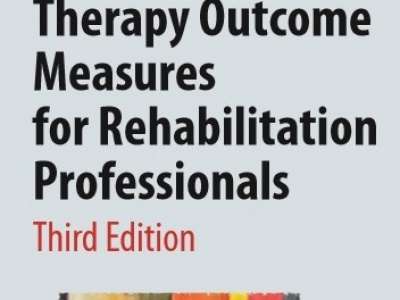
Pages (excluding the index): 224; RRP: £34.99
This book aims to give service providers everything they need to know about how to measure the impact of their service on outcomes for service users. It begins with the development and theoretical underpinning of Therapy Outcome Measures (TOM) and how to use the measure, gives real-life examples, and provides an impressive 47 scales with data collection forms. A CD-ROM is included with copies of the materials needed.
TOM is essentially a tool to help clinical managers demonstrate that they are delivering effective services by recording where a patient/client starts, and subsequently ends their journey, after accessing their service. Originally developed for speech and language services in 1992, TOM has since been developed for use by occupational therapy, physiotherapy, rehabilitation, equipment and hearing therapy services.
The background to, and validation of, TOM is thoroughly described in the opening chapters and will provide anyone with an interest in outcome measures with an evidence-based and historical overview.
The list of services within which TOM can be used (referred to as scales in the measure) is extensive – 47 in total – and includes mental health (e.g. anxiety, post-natal depression); medical (e.g. respiratory care, diabetes); speech and language (e.g. dysarthria, dysphasia); neurology (e.g. stroke, cerebral palsy); dietetics (e.g. IBS, obesity); and hearing therapy. Other scales such as anorexia/bulimia, enteral feeding and podiatric conditions are listed as being under development, which suggests that final consensus has not yet been reached on the scale descriptors.
Each scale is broken down into four domains – impairment, activity, participation and well-being. These domains are based on the International Classification of Functioning which most people are already familiar with. Scales such as Alternative and Augmentative Communication and Equipment services have the impairment domain further divided into physical, cognitive, sensory, speech and language output and comprehension to reflect the complexity of these services.
Each domain has six-point ordinal scale descriptors (scoring 0 – 5) with a further half point available if someone fits best between two descriptors. Descriptors for each domain are scored at the start of intervention and again at the end.
I think it probably sounds more complicated than it is, and useful real-life examples are given from a range of services such as AAC, Equipment, Palliative Care, and Pulmonary Rehabilitation.
Keys to the success of using TOM are the need for a service benchmarking exercise to determine a baseline of service delivery; all staff within a service to be trained and using TOM consistently; and the data collected to be analysed, reviewed and reported on, with changes to service delivery implemented as required. Anonymous examples of benchmarking are provided, demonstrating that it’s not an exercise for faint-hearted managers, as obvious instances of underperformance can be highlighted. Implementing TOM in a service is therefore not likely to be a quick fix, and requires some dedicated leadership and investment in time and training to embed successfully and then implement changes, especially where areas of underperformance have been identified.
The greatest relevance to the PMG reader is likely to be the Equipment or AAC scales, as these most accurately reflect the multi-faceted nature of our complex services.
To sum up, I can see the pros of this measure as its wide application in healthcare settings and professionals, speed to administer (once trained), the inclusion of participation and caregivers, and its ability to give information about the needs of a population. However, it does need everyone on board, and if the data yielded is not compatible with data required by commissioners, I can’t see it being a priority in already-stretched services. It’s not specific enough for individual outcomes (it’s not going to help you plan a specific intervention for Mr or Mrs Smith). However, if you are looking for a validated measure to show that your service delivers what your patients need, then £35 is not going to break the budget to give you a starting point.
The Community Therapy online shop is currently offering the book at a discounted price of £30. Go to www.communitytherapy.org.uk and quote the discount code TOM30.






.jpg)



no comments
Add your comment...